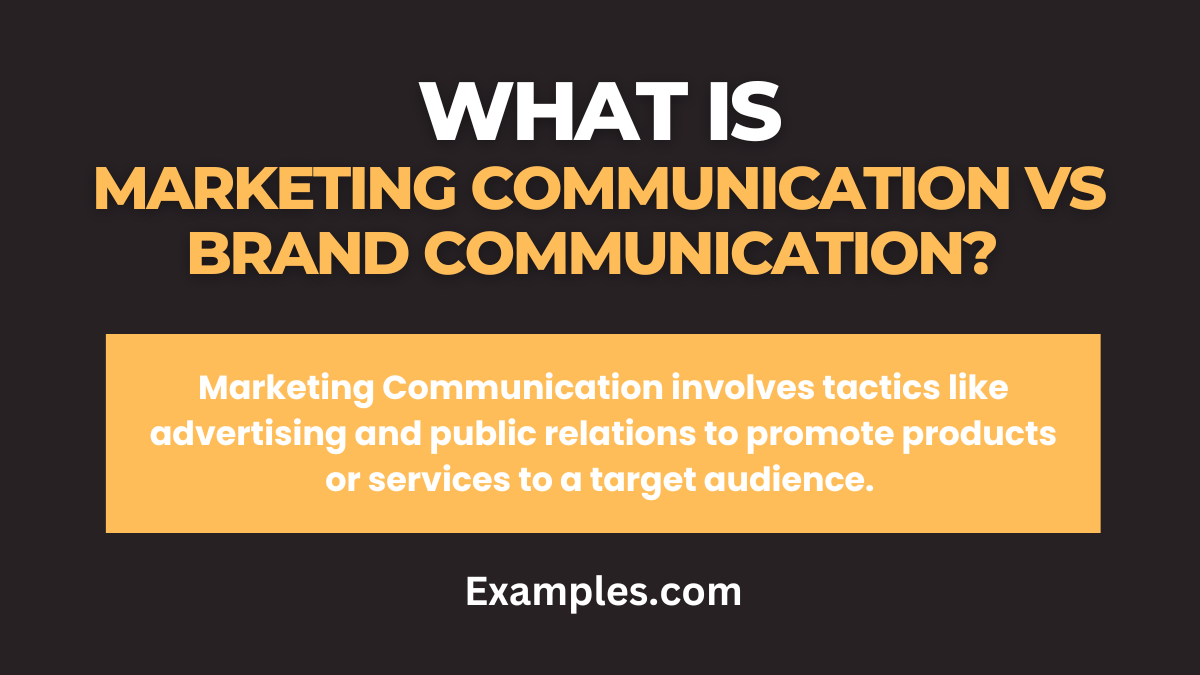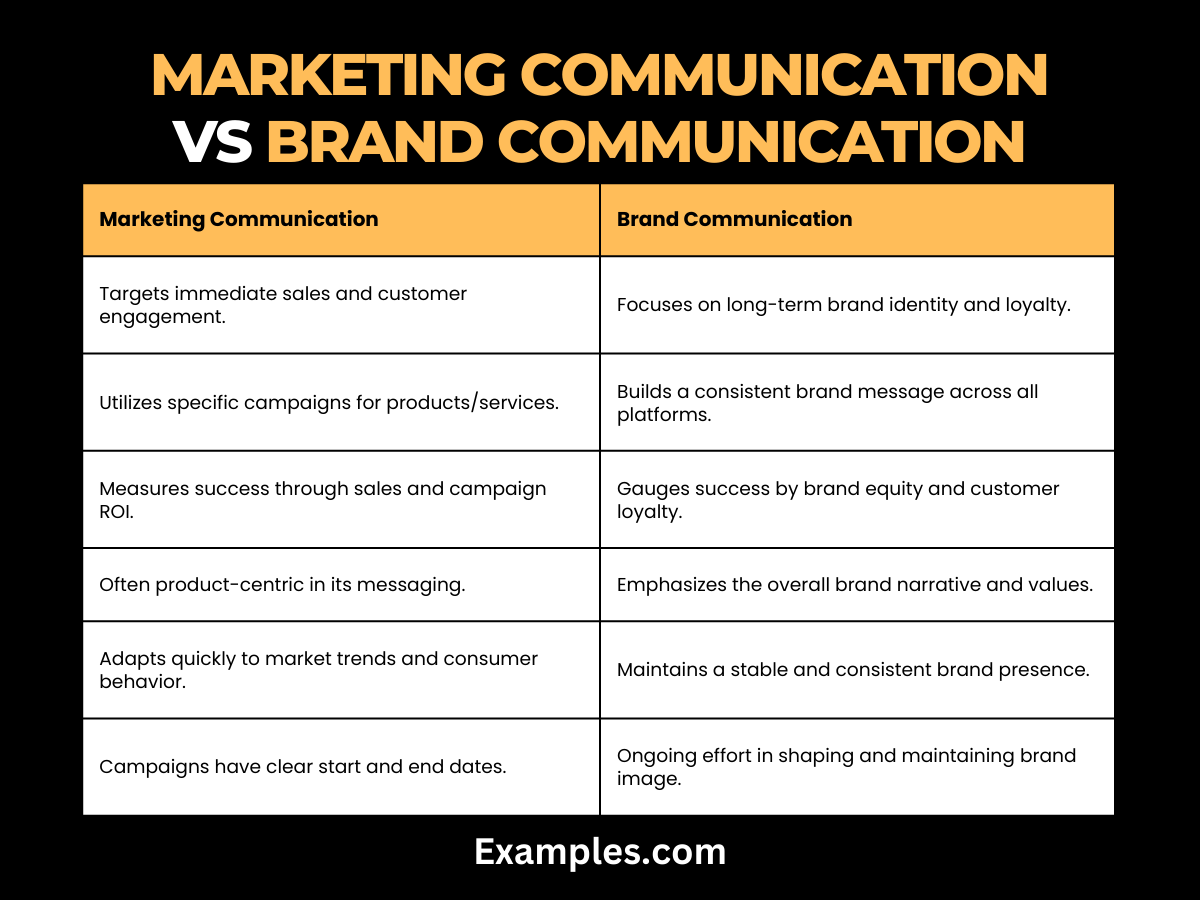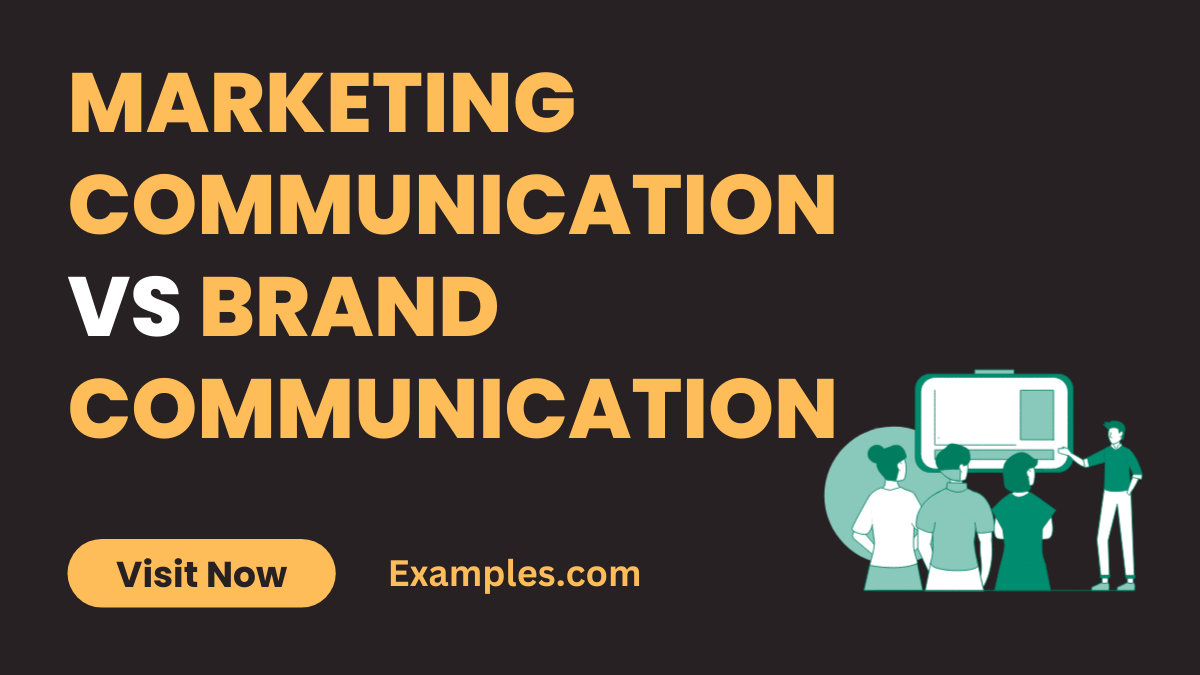Marketing Communication vs Brand Communication – 19+ Examples
Embark on an insightful journey through the distinct realms of Marketing Communication and Brand Communication. This detailed guide, enriched with diverse Marketing Communication Examples, delves into their unique functions and interplay in shaping a brand’s identity and market presence. Ideal for marketers and brand strategists, this resource unpacks each concept with practical examples, offering a clear understanding of how to effectively employ these communication strategies for maximum brand impact.
What is Marketing Communication vs Brand Communication?

Marketing Communication involves tactics like advertising and public relations to promote products or services to a target audience. Brand Communication, on the other hand, focuses on building and maintaining a strong brand identity, encompassing all forms of communication that contribute to the perception of the brand in the market and public eye.
Difference between Marketing Communication and Brand Communication
This table presents a clear comparison between Marketing Communication and Brand Communication, highlighting their distinct roles, strategies, and objectives in the business environment. Understanding these differences is crucial for organizations to effectively allocate resources and develop comprehensive communication strategies that support both immediate sales goals and long-term brand building.

| Marketing Communication | Brand Communication |
|---|---|
| Primarily focuses on tactics to promote and sell products or services, utilizing a mix of advertising, direct marketing, and sales promotions. | Centers on building a consistent brand identity and image, encompassing the brand’s values, personality, and message across all channels. |
| Aims to influence consumer behavior in the short term, often driving immediate sales, product awareness, and customer acquisition. | Aims to establish a deep, emotional connection with the audience, fostering long-term loyalty and a strong brand reputation. |
| Utilizes a variety of channels specific to campaigns, including traditional media like TV and radio, as well as digital platforms. | Utilizes a broad spectrum of communication channels, ensuring the brand message remains consistent whether in PR, social media, or internal communications. |
| Metrics for success include sales volume, market share, and the effectiveness of specific campaigns. | Measures success through brand equity, customer loyalty, brand recall, and the overall health of the brand in the market. |
| Often features persuasive messaging tailored to specific products or services, highlighting benefits and unique selling points. | Features messaging that aligns with the overarching brand story and identity, often going beyond just the products to encompass the brand’s ethos and values. |
| Dynamic and flexible, changing strategies based on market trends, consumer behaviors, and immediate business goals. | More consistent and stable over time, with changes made carefully to maintain brand integrity and customer trust. |
| Directly impacts the company’s bottom line in terms of sales and immediate financial return on investment. | Indirectly impacts the bottom line over a longer term, building a foundation of customer trust and preference that supports all business activities. |
| Marketing communication messages can vary greatly from campaign to campaign, adapting to different market segments and consumer needs. | Maintains a consistent tone, style, and message across all communications, reinforcing the brand’s identity and differentiating it from competitors. |
| Often product-centric, focusing on the features, advantages, and benefits of specific products or services. | Holistic and brand-centric, focusing on conveying the overall brand experience and the lifestyle or values it represents. |
| Usually seen in the form of specific campaigns with clear start and end dates, aligned with product launches, sales seasons, or market opportunities. | An ongoing process that is embedded in every interaction with customers, stakeholders, and the public, creating a cumulative effect on brand perception. |
10 Examples of Marketing Communication
Marketing Communication (MarCom) is an essential tool for businesses to promote their products or services. Here are ten key examples:
- TV Commercials: Utilizing television to broadcast persuasive messages to a wide audience.
- Print Ads: Advertising in newspapers, magazines, and brochures to target specific demographics.
- Radio Advertising: Reaching local or niche audiences through catchy and memorable audio messages.
- Online Banner Ads: Digital advertisements on websites and platforms to drive web traffic and sales.
- Social Media Posts: Engaging with customers through platforms like Facebook, Instagram, and Twitter.
- Email Campaigns: Sending targeted promotional or informational content to a subscribed audience.
- Brochures and Flyers: Distributing printed materials to provide detailed product or service information.
- Outdoor Billboards: Large-format advertising in public spaces for high visibility and brand awareness.
- Direct Mail: Personalized postal communications for promotions or updates.
- Event Marketing: Participating in or sponsoring events to promote products and engage with the audience.
10 Examples of Brand Communication
Brand Communication is about establishing and maintaining a positive image of the company’s brand. Here are ten examples:
- Brand Storytelling: Using narrative techniques across various media to convey the brand’s values and mission.
- Corporate Websites: Offering comprehensive information about the company’s ethos, history, and offerings.
- Brand Videos: Creating video content that embodies the brand’s identity and message.
- Public Relations (PR): Managing media relations to maintain a positive public image of the brand.
- Social Responsibility Campaigns: Initiatives that showcase the brand’s commitment to social or environmental issues.
- Internal Communications: Keeping employees informed and aligned with the brand’s values and goals.
- Customer Testimonials: Using real-life stories to build trust and authenticity around the brand.
- Corporate Events: Hosting or participating in events that reflect the brand’s image and values.
- Influencer Partnerships: Collaborating with individuals whose followers align with the brand’s target audience.
- Content Marketing: Creating valuable and informative content that reflects the brand’s voice and expertise.
Comparison Between Marketing Communication and Brand Communication
In the world of business communication, distinguishing between Marketing Communication and Brand Communication is pivotal for devising effective strategies. While they overlap, each serves a distinct purpose and employs different methods. This guide compares these two essential aspects of communication to provide clarity on their roles in a business’s strategy.
- Primary Focus: Marketing Communication primarily aims to promote and sell products or services. It often involves direct tactics like advertising, Sales Promotion Communication in Marketing, and Direct Communication in Marketing. Brand Communication, however, is focused on building and maintaining a consistent brand identity across all platforms.
- Target Audience: Marketing Communication typically targets potential and current customers with a sales-driven approach. In contrast, Brand Communication addresses a broader audience, including stakeholders, employees, and the general public, to create a comprehensive brand image.
- Strategies Employed: Marketing Communication Strategies include specific campaigns and promotions, leveraging Email Marketing Communication, Event Marketing Communication, etc. Brand Communication, however, encompasses broader strategies like brand storytelling, corporate values communication, and long-term reputation management.
- Measuring Success: The success of Marketing Communication is often measured by short-term metrics like sales figures and campaign ROI. Brand Communication success is gauged over a longer term, focusing on brand loyalty, recognition, and reputation.
- Content and Messaging: Marketing Communication uses persuasive and often product-centric messages. Brand Communication conveys the brand’s values, personality, and unique selling propositions, creating an emotional connection with the audience.
Relationship Between Marketing Communication and Brand Communication
While Marketing Communication and Brand Communication have distinct roles, they are deeply interconnected and mutually reinforcing. This section explores how these two forms of communication work in tandem to create a cohesive and effective overall communication strategy for a business.
- Complementary Goals: Marketing Communication drives sales and market share growth, while Brand Communication builds the brand equity that underpins long-term business success. Together, they create a strong market presence.
- Consistent Brand Messaging: Effective Marketing Communication should align with the brand’s core messages and values established in Brand Communication. This consistency ensures that all marketing efforts reinforce the brand identity.
- Leveraging Brand Strength in Marketing: A strong brand, built through effective Brand Communication, can enhance the impact of Marketing Communication efforts, making campaigns more credible and appealing to the audience.
- Holistic Communication Approach: Integrating Marketing and Brand Communication ensures that all customer touchpoints convey a unified message, enhancing customer experience and brand perception.
- Adaptive Strategies: In a rapidly changing market, the relationship between Marketing and Brand Communication allows businesses to adapt quickly. Marketing can respond to immediate market changes, while Brand Communication maintains long-term brand consistency.



